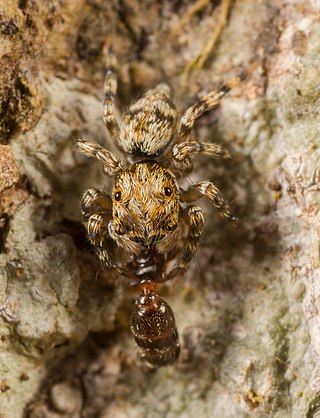
Huntsman spiders, members of the family Sparassidae, are known by this name because of their speed and mode of hunting. They are also called giant crab spiders because of their size and appearance. Larger species sometimes are referred to as wood spiders, because of their preference for woody places. In southern Africa the genus Palystes are known as rain spiders or lizard-eating spiders. Commonly, they are confused with baboon spiders from the Mygalomorphae infraorder, which are not closely related.

Oonopidae, also known as goblin spiders, is a family of spiders consisting of over 1,600 described species in about 113 genera worldwide, with total species diversity estimated at 2000 to 2500 species. The type genus of the family is OonopsKeyserling, 1835.

Liocranidae is a family of araneomorph spiders first described by Eugène Simon in 1897. They are one of several groups called "sac spiders". The holarctic genus Agroeca is the best-known, but it also includes various genera of more obscure spiders that still lack a diagnosis. Two species in the North American genus Neoanagraphis are found in the extremely dry conditions in the Mojave, Sonoran and Chihuahuan deserts. Females live in animal burrows while males wander and are the ones most often caught in pitfall traps.

Wandering spiders (Ctenidae) are a family of spiders that includes the Brazilian wandering spiders. These spiders have a distinctive longitudinal groove on the top-rear of their oval carapace similar to those of the Amaurobiidae. They are highly defensive and venomous nocturnal hunters. Wandering spiders are known to hunt large prey, for example hylid species Dendropsophus branneri. Despite their notoriety for being dangerous, only a few members of Phoneutria have venom known to be hazardous to humans, but the venoms of this family are poorly known, so all larger ctenids should be treated with caution.

Zoropsidae, also known as false wolf spiders for their physical similarity to wolf spiders, is a family of cribellate araneomorph spiders first described by Philipp Bertkau in 1882. They can be distinguished from wolf spiders by their two rows of eyes that are more equal in size than those of Lycosidae.

Aelurillus is a genus of spiders in the family Salticidae.

Habrocestum is a genus of jumping spiders first described in 1876. They mostly occur in Eurasia and Africa, though one species has been found in Australia and another on the Solomon Islands.
Mogrus is a genus of jumping spiders that was first described by Eugène Louis Simon in 1882.

Stenaelurillus is a genus of jumping spiders that was first described by Eugène Louis Simon in 1886. Most species live in Africa, with some species found in Asia, including China. All species have two white longitudinal stripes on the carapace, and both sexes show strong bristles around the eyes. The name is a combination of the Greek sten- "narrow" and the salticid genus Aelurillus.

Idiopidae, also known as armored or spiny trapdoor spiders, is a family of mygalomorph spiders first described by Eugène Simon in 1889.

Olios is the largest genus of huntsman spiders, containing 166 species. They are found throughout the world, with most species occurring in hot countries. The genus was first described by Charles Athanase Walckenaer in 1837.
Simalio is a genus of sac spiders first described by Eugène Simon in 1897.
Oedignatha is a genus of Asian spiders first described by Tamerlan Thorell in 1881 as a genus of corinnid sac spiders, and moved to Liocranidae in 2014.
Diallomus is a genus of Asian wandering spiders first described by Eugène Simon in 1897. As of April 2019 it contains only two species, both found in Sri Lanka. Originally placed with the Zoridae, it was moved to Ctenidae in 2003.
Stasina is a genus of huntsman spiders that was first described by Eugène Louis Simon in 1877. Many former species have been transferred to Thelcticopis and Neostasina.
Monaeses is a genus of crab spiders in the family Thomisidae, containing twenty seven species.









